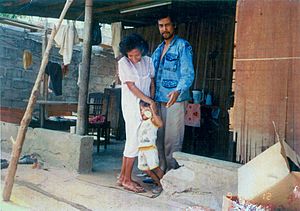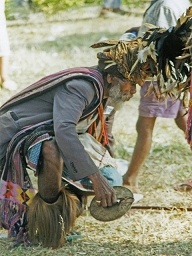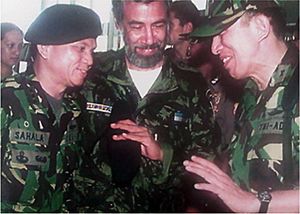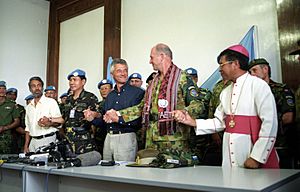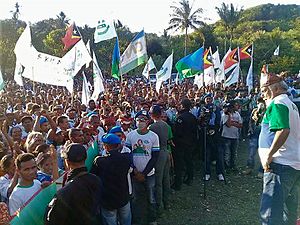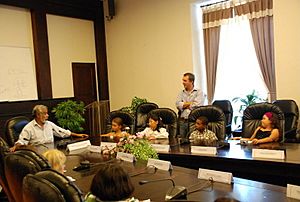Xanana Gusmão facts for kids
Quick facts for kids
Xanana Gusmão
|
|
|---|---|
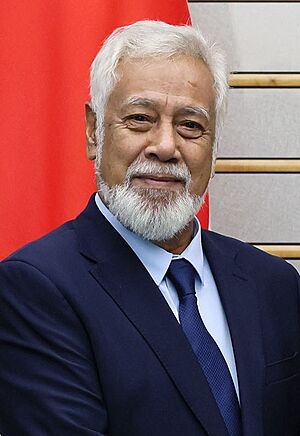
Gusmão in 2023
|
|
| 6th & 10th Prime Minister of East Timor | |
| Assumed office 1 July 2023 |
|
| President | José Ramos-Horta |
| Deputy |
|
| Preceded by | Taur Matan Ruak |
| In office 8 August 2007 – 16 February 2015 |
|
| President |
|
| Preceded by | Estanislau da Silva |
| Succeeded by | Rui Maria de Araújo |
| 3rd President of East Timor | |
| In office 20 May 2002 – 20 May 2007 |
|
| Prime Minister |
|
| Preceded by | Sérgio Vieira de Mello as UN Administrator (1999–2002) Nicolau dos Reis Lobato as acting president (1975–1978) |
| Succeeded by | José Ramos-Horta |
| Personal details | |
| Born |
José Alexandre Gusmão
20 June 1946 Manatuto, Portuguese Timor |
| Political party | National Congress for Timorese Reconstruction |
| Spouses | |
| Children | 5 |
| Residences | New South Wales, Australia |
| Signature |  |
José Alexandre "Xanana" Gusmão (born June 20, 1946) is an important politician from East Timor. He has served as the Prime Minister of East Timor since 2023. He was also Prime Minister from 2007 to 2015. Before that, he was East Timor's first President from 2002 to 2007, after the country became independent again.
Contents
Early Life and Education
Xanana Gusmão was born in Laleia, Manatuto, in what was then called Portuguese Timor. He was the second child in a big family. His parents were both school teachers.
He went to a Jesuit school near Dili, the capital city. When he was 15, he had to leave high school because of money problems. He worked different jobs but kept studying at night.
In 1965, when he was 19, Gusmão met Emilia Batista, who later became his first wife. His nickname, "Xanana," came from an American rock and roll band called "Sha Na Na."
In 1966, Gusmão got a job in public service, which helped him continue his education. He joined the Portuguese Army in 1968 and served for three years, becoming a corporal. During this time, he married Emilia Batista and had two children, Eugenio and Zenilda. He later divorced Emilia. In 2000, he married Kirsty Sword, an Australian, and they had three sons: Alexandre, Kay Olok, and Daniel.
After his army service in 1971, Gusmão became involved with a group that wanted East Timor to be independent. For the next three years, he took part in peaceful protests against the colonial system.
Fight for Independence
In 1974, a big change happened in Portugal, which led to Portuguese Timor starting its journey to independence. Plans were made for elections to happen before independence in 1978.
During 1975, there was a struggle between two groups in Portuguese Timor. Gusmão joined the Fretilin group. He was arrested and put in prison by the other group, the Timorese Democratic Union (UDT).
While there was disorder, Indonesia started to cause problems and raided Portuguese Timor from West Timor. By late 1975, Fretilin took control, and Gusmão was released. He became the Press Secretary for Fretilin. On November 28, 1975, Fretilin declared East Timor independent. Gusmão filmed this important ceremony.
Just nine days later, Indonesia invaded East Timor. Gusmão was outside Dili and saw the invasion from the hills. He spent the next few days looking for his family.
Resistance Against Occupation
After Indonesia took over, Gusmão became very active in the resistance movement. He helped organize the resistance, which was key to its eventual success. He walked from village to village to get support and new members.
In 1981, he was chosen to lead Falintil, the armed wing of the resistance. In 1988, Gusmão became the leader of the new National Council of Resistance (CNRT). He left Fretilin to show he was working for all groups. Under his leadership, Falintil used secret networks and small groups to attack Indonesian targets.
In the early 1990s, Gusmão worked hard to tell the world what was happening in East Timor. He was very important in bringing attention to the Dili Massacre on November 12, 1991. Many news channels interviewed Gusmão, and he gained worldwide attention.
Because he was so well-known, Gusmão became a main target for the Indonesian government. Indonesian troops tried to capture him several times. In November 1992, they finally succeeded. Gusmão was caught in a tunnel near Dili and taken to Bali.
In May 1993, Gusmão was put on trial by the Indonesian government. He was found guilty of rebellion and other charges and sentenced to life in prison. This sentence was later changed to 20 years by the Indonesian President. He was sent to a high-security prison in Jakarta. Even from prison, Gusmão continued to lead the resistance with help from Kirsty Sword. Before he was released, important people like Nelson Mandela visited him.
Path to Independence
On August 30, 1999, the people of East Timor voted in a referendum, and most voted for independence. After this, the Indonesian military started a campaign of violence. The Indonesian government was criticized for not stopping this. Because of strong pressure from the United Nations, an international peacekeeping force, led by Australia, entered East Timor.
Gusmão was secretly brought back to East Timor by this force on October 21, 1999. He gave a speech urging everyone to work together and rebuild the country. He was expected to become the first President.
In 1999, Xanana Gusmão was chosen to be the speaker of the National Consultative Council (NCC), a temporary parliament during the UN's time in East Timor. He also became a spokesman for the National Council (NC) in 2000. Gusmão played a big role in the UN administration that governed East Timor until May 20, 2002. During this time, he worked for unity and peace in East Timor.
Elections were held in late 2001. Gusmão ran as an independent candidate and was easily elected. He won the presidential election on April 14, 2002, with 82.7% of the votes. He became the first President of East Timor when it officially became independent on May 20, 2002.
Leading Independent East Timor
On June 21, 2006, Gusmão asked Prime Minister Mari Alkatiri to resign. There were serious accusations against Alkatiri, which led to many protests. Alkatiri resigned on June 26, 2006, to end the uncertainty. A UN Commission later looked into the accusations and found them to be false. The commission also noted that Gusmão had made some strong statements during the crisis.
Gusmão decided not to run for president again in the April 2007 election. He said he would lead his new party, the National Congress for Timorese Reconstruction (CNRT), in the parliamentary election later that year. He also said he would be willing to become prime minister if his party won. José Ramos-Horta became the new president on May 20, 2007.
The CNRT came in second in the June 2007 parliamentary election. They formed a group with other parties to create a majority in parliament. After some disagreements, President Ramos-Horta announced on August 6 that the CNRT-led group would form the government. Gusmão became Prime Minister on August 8, 2007.
On February 11, 2008, Gusmão's car came under gunfire. This happened an hour after President José Ramos-Horta was shot. Gusmão's home was also taken over by rebels. These events were seen as possible attempts to harm or kidnap leaders.
In the 2012 parliamentary elections, Gusmão's CNRT party was the strongest. He continued to lead the government as Prime Minister and Minister of Defence.
In early 2015, Gusmão announced he would step down as Prime Minister. He suggested Rui Maria de Araújo as his replacement. President Taur Matan Ruak accepted his resignation, and Araújo became the new Prime Minister on February 16. In the new government, Gusmão became a "Consultative Minister" and Minister of Planning and Strategic Investment.
In the 2017 parliamentary elections, Gusmão's CNRT party came in second. He announced he would resign as party leader, but his party did not accept it. The CNRT went into opposition, and Gusmão lost his ministerial job.
Gusmão played a key role in solving the border disputes between Australia and East Timor. After a new border treaty was signed on March 6, 2018, he received a hero's welcome when he returned to Dili. In the 2018 general elections, Gusmão was part of the Alliance for Change and Progress (AMP) and entered parliament. He later stepped down from his parliamentary seat. He was appointed Minister of State and Minister of Planning and Strategic Investment, but he did not take the oath of office due to disagreements with the President. He continued to work on maritime boundary negotiations with Australia until 2022.
In the 2022 presidential elections, Gusmão supported José Ramos-Horta as the CNRT candidate. Ramos-Horta won and began his second term as President on May 20, 2022.
In October 2022, Gusmão stepped in to help families in Dili who were being evicted from their homes. He ordered police officers to return the families' belongings to their houses. This event became known as the "Aimeti Laran case" and the "Becussi Craic." A judicial council later stated that the judge involved had acted correctly.
In the 2023 East Timorese parliamentary election, the CNRT won the most votes, getting 31 out of 65 seats in the National Parliament. On July 1, 2023, Gusmão was sworn in as Prime Minister again after his party's victory.
Awards and Recognition
Awards
- In 1999, Gusmão received the Sakharov Prize for Freedom of Thought.
- In 2000, he was given the Sydney Peace Prize for being a "courageous and principled leader for the independence of the East Timorese people."
- Also in 2000, he won the first Gwangju Prize for Human Rights.
- In 2002, he was awarded the North–South Prize by the Council of Europe.
- Gusmão is an important member of the Sérgio Vieira de Mello Foundation.
Honours
 Brazil:
Brazil:
 Collar of the Order of the Southern Cross (2012)
Collar of the Order of the Southern Cross (2012)
 Indonesia:
Indonesia:
 New Zealand:
New Zealand:
 Honorary Companion of the New Zealand Order of Merit (July 6, 2000)
Honorary Companion of the New Zealand Order of Merit (July 6, 2000)
 Portugal:
Portugal:
 Grand Collar of the Order of Prince Henry (February 14, 2006)
Grand Collar of the Order of Prince Henry (February 14, 2006) Grand Cross of the Order of Liberty (June 9, 1993)
Grand Cross of the Order of Liberty (June 9, 1993)
 United Kingdom:
United Kingdom:
 Honorary Knight Grand Cross of the Most Distinguished Order of Saint Michael and Saint George (2003)
Honorary Knight Grand Cross of the Most Distinguished Order of Saint Michael and Saint George (2003)
Works
Xanana Gusmão has written several books, including:
- A Travesty of Justice: Xanana's Defence (1996)
- Inside Out East Timor (1999)
- To Resist is to Win!: The Autobiography of Xanana Gusmão with Selected Letters & Speeches (2000)
- Timor Lives! speeches of freedom and independence (2005)
- Strategies for the Future: Speeches 2007-2011 (2012)
- Raising a Nation: The Speeches of Xanana Gusmao 2011-2014 (2015)
He is also the main narrator in the 2006 documentary film A Hero's Journey/Where the Sun Rises, which is about him and East Timor.
See also
 In Spanish: Xanana Gusmão para niños
In Spanish: Xanana Gusmão para niños


